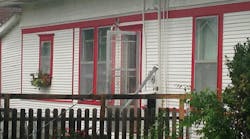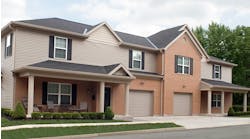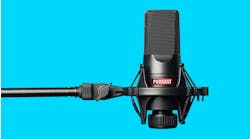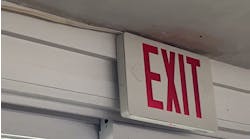A homeowner wakes up one morning and realizes he has no electricity. Soon after, an electric utility truck rolls up, and two utility workers approach the home. They spend a few minutes assessing the situation, and then return to their truck to gather the tools necessary to complete their work. They carefully cut the conductors at the customer’s overhead service and tape them up. Next, they roll up the service conductors and attach them to the utility pole at a height where they will not harm anyone. Prior to leaving, they attach a note to the door — and drive away.
Realizing he still has no electricity, the discouraged homeowner opens the door and finds the note, informing him that the electrical service equipment is damaged and needs the attention of a licensed electrical contractor before service can be restored. Confused, the homeowner calls an area electrical contractor and asks for assistance.
The receptionist who answers the phone takes the homeowner’s information and proceeds to tell him that the electrical contractor and crew will be there in three to five days. Furious, the homeowner calls the electric utility and demands satisfaction. An electric utility customer service representative visits the site and explains to the customer the difference between customer-owned equipment and utility-owned equipment. Only then does the homeowner truly understand the meaning of the term “service point” (Photo 1).
How many homeowners do you think own a copy of the National Electrical Code? My guess is not many. With that being the case, you can better understand how issues might arise between the serving electric utility and the installer or customer when it comes to responsibilities for connection of electricity to a dwelling. Photo 2 shows the connection of the utility service drop to the service entrance conductors at a typical dwelling unit. Let’s review these terms as defined in Art. 100 of the NEC.
- The service drop is defined as the overhead conductors between the utility electric supply system and the service point.
- The service-entrance conductor (for an overhead system) is defined as the conductors between the terminals of the service equipment and a point typically outside the building, clear of building walls, where joined by tap or splice to the service drop or overhead service conductors. Careful examination of Photo 2 shows the connection point via splice conductors between the service drop (utility responsibility) and the service-entrance conductors (the installer or homeowner’s responsibility).
As defined in the 2020 NEC, the service point is the point of connection between the facilities of the serving utility and the premises wiring system. An important informational note clarifies that the service point can be described as the point of demarcation between where the serving utility ends and the premises wiring begins. The serving utility generally specifies the location of the service point based on the conditions of service. Did you catch that? Who generally specifies the location for the service point? The electric utility is typically responsible for this specification (Fig. 1 and Fig. 2).
The typical components of an electrical service are numerous. Figure 3 shows these components and outlines the responsibility of the electric utility and the contractor/homeowner. As you can see from our discussion about the term service point, most components shown in Fig. 3 are the responsibility of the installer/homeowner. An exception in some instances is the meter base. In certain cases, the utility provider will specify and provide the meter base as part of the service requirements for a building. Always speak to your electric utility to understand their service installation guidelines and requirements. These requirements are key to getting the electrical service at a building connected — even if the electrical inspector has passed the service inspection.
Electrical contractors, electrical inspectors, and electrical utility personnel must work hand in hand to bring back the electricity when a disturbance occurs. What a beautiful image this working relationship brings to mind — all of these individuals working to achieve one goal (getting power restored to the customer). They are all heroes in my book, often giving up their personal time with family and friends to assist others in their time of need and carrying on the tradition of keeping the public electrically safe.
Wages, Jr., is the technical advisor, education, codes and standards for IAEI. He represents IAEI on NFPA’s NEC Code-Making Panel-2 for the 2020 NEC. He also serves on the UL Electrical Council and on several UL Technical Standard Panels. Wages, Jr., is an ICC-certified building official and an IAEI-certified electrical inspector for one- and two-family dwellings. He can be reached at [email protected].
Inspector Intel articles are provided by the International Association of Electrical Inspectors (IAEI), www.iaei.org, a membership-driven, non-profit association headquartered in Richardson, Texas, that promotes electrical safety throughout the industry by providing education, certification of inspectors, advocacy, partnerships, and expert leadership in electrical codes and standards.








